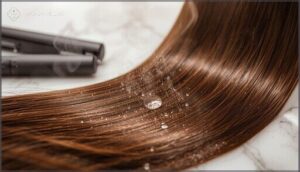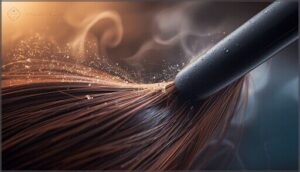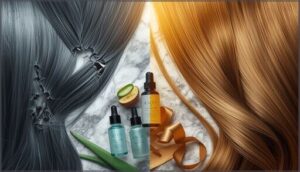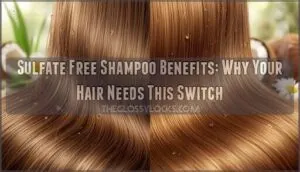This site is supported by our readers. We may earn a commission, at no cost to you, if you purchase through links.
Your flat iron sits at 450°F—hot enough to sear a steak. Now imagine what it’s doing to your hair. Most people crank up the heat thinking hotter means faster and sleeker results.
But here’s the reality: anything above 300°F starts breaking down the protein bonds that give your hair its strength and elasticity. Once those bonds break, the damage is permanent. You can’t reverse it with conditioner or expensive treatments.
The good news? You don’t have to ditch your styling tools to keep your hair healthy. A few smart tweaks to your routine can protect your strands from thermal damage while still giving you the smooth, polished look you want.
Table Of Contents
- Key Takeaways
- What Causes Heat Damage?
- Best Practices for Preventing Heat Damage
- Choosing The Right Tools and Products
- Hair Care Tips for Ongoing Protection
- How to Repair Heat-Damaged Hair
- Frequently Asked Questions (FAQs)
- How can I protect my hair from heat damage?
- What is heat damage and how to prevent it?
- How to repair heat damaged hair?
- How can we protect against extreme heat?
- Can heat damage be reversed?
- How to prevent heat disorders?
- Can heat damage affect hair growth rate?
- Does hair porosity influence heat damage susceptibility?
- Are ceramic tools safer than metal plates?
- How long does heat damage take to occur?
- Conclusion
Key Takeaways
- Heat damage becomes permanent above 300°F when your hair’s protein bonds break down, so keep styling tools between 250°F and 300°F and limit heat styling to once or twice weekly.
- Always apply heat protectant on dry hair before styling—it cuts thermal damage by up to 44% and creates a protective barrier that locks in moisture.
- You can’t reverse heat damage, but deep conditioning weekly, protein treatments every 4-6 weeks, and regular trims will make damaged hair look healthier and prevent further breakage.
- Quality ceramic tools with adjustable temperature controls distribute heat evenly and reduce damage risk by 30% compared to cheap metal plates that create dangerous hotspots.
What Causes Heat Damage?
Heat damage doesn’t happen by accident. Your flat iron and blow dryer are actually changing the structure of your hair every time you use them.
Let’s break down what’s really going on so you can protect your strands before the damage sets in.
How Heat Styling Affects Hair Structure
When you blast your hair with heat, you’re not just styling—you’re breaking it down at a molecular level. Heat styling causes cuticle disruption and protein denaturation, which weakens your hair fiber damage resistance.
The protective outer layer lifts and cracks, exposing the inner structure to keratin breakdown and thermal degradation. This isn’t surface-level stuff—it compromises your hair structure and overall hair health from the inside out.
Understanding the effects of heat damage issues is vital to preventing long-term harm.
The Role of Temperature in Hair Damage
So how hot is too hot? Hair denaturation starts around 284°F, but real damage kicks in above 300°F when keratin breaks down. That’s where heat damage turns irreversible.
Hair denaturation begins at 284°F, but irreversible damage happens above 300°F when keratin breaks down
For thermal protection and damage prevention, keep your heat styling tools between 250°F and 300°F—lower if your hair’s fine or chemically treated. Temperature control isn’t optional. It’s how you avoid thermal damage before it happens. Understanding the right hair temperature settings is essential for maintaining healthy hair.
Signs and Symptoms of Heat-Damaged Hair
Now that you know the temps to avoid, let’s talk about spotting heat damage signs before things get worse. Dryness effects show up first—your hair feels rough and thirsty. Then come split ends and hair breakage patterns that snap mid-strand.
Hair frizz causes multiply as cuticles crack open. Thermal damage steals your shine and bounce, leaving strands brittle and dull.
Best Practices for Preventing Heat Damage
You don’t have to give up your flat iron or curling wand to keep your hair healthy. The key is learning how to use heat the right way so you’re not sacrificing your hair’s strength and shine.
Here are three essential practices that’ll help you style with confidence while keeping damage at bay.
Limit Frequency of Heat Styling
Think of your hair like a phone battery—the more you charge it daily, the faster it wears out. Limit heat styling to 1-2 times per week to dodge thermal damage and hair breakage. Fine hair? Once weekly is safer.
These styling intervals give your strands time to recover from those hydrogen bond disruptions that cause brittleness. Your hair will thank you with better bounce and strength.
Always Use a Heat Protectant
Heat protectants slash thermal damage by up to 44% when you apply them before heat styling. These protective sprays create a thermal shielding barrier that locks in moisture and guards your hair fibers against extreme temperatures.
Look for these key ingredients in your heat damage prevention arsenal:
- Silicones like dimethicone that coat strands and reduce water loss
- Quaternary 70 and copolymers for enhanced thermal protection
- Natural oils with high smoke points for added hair protection
- Panthenol and humectants that maintain hydration under heat
Apply evenly on slightly damp hair for best results.
Avoid Styling Wet or Damp Hair
Wet hair risks are real. When you apply heat to damp strands, water inside the hair fiber rapidly boils and creates tiny steam bubbles that fracture your hair from within. This bubble hair effect weakens your strands at temperatures as low as 345°F.
For damage prevention and thermal styling safety, always dry your hair to at least 80% before reaching for heat styling tools. Your hair health depends on it.
Choosing The Right Tools and Products
You can’t prevent heat damage with good habits alone. The tools you use and the products you put on your hair matter just as much as how often you style it.
Here’s what to look for when you’re shopping for heat tools and protectants.
Set Styling Tools to Safe Temperatures
Your flat iron’s dial isn’t just decoration—it’s your first line of defense against damage prevention. Most of us crank the heat settings to max, but that’s like bringing a flamethrower to light a candle. Smart temperature control matters more than you think for styling safety and thermal styling safety.
Here’s your heat styling cheat sheet:
- Fine hair? Stay between 250°F and 300°F—anything higher risks instant brittleness.
- Medium or wavy texture? Aim for 300°F to 356°F with your heat protectant applied first.
- Thick or curly? You can push to 375°F, but start lower and test.
- Chemically treated? Keep it under 300°F to avoid compounding existing damage.
- General rule: One or two passes at the right temp beats multiple passes at scorching heat.
The science backs this up: below 280°F, you’re mostly dealing with reversible changes. Cross 392°F and you’re melting your hair’s protein structure. Heat damage happens fast at extreme temperatures, so dial it down and let good heat styling techniques do the work. Your hair will thank you.
Invest in Quality Heat Styling Tools
Not all styling tools are created equal—cheap ones often have uneven heat settings that can fry your hair in seconds.
Quality heat styling tools with ceramic plates and ionic technology distribute heat evenly, cutting your risk of heat damage by up to 30%. Look for adjustable heat settings and tool material that protects instead of punishes.
Your strands deserve better than bargain-bin burners.
Benefits of Argan Oil Heat Protectors
Think of argan oil as your hair’s bodyguard against heat damage. This heat protectant creates a thermal barrier up to 420°F, while its omega-6 fatty acids lock in moisture and prevent dryness.
The vitamin E fights free radicals from styling tools, giving you frizz control and shine without the grease. It’s thermal protection and hair nourishment in one lightweight step.
Hair Care Tips for Ongoing Protection
Protecting your hair from heat doesn’t stop when you put down the flat iron. Your everyday routine plays a huge role in keeping your strands strong and resilient.
Here are four simple habits that’ll help you maintain healthy hair between styling sessions.
Moisturizing Shampoos and Conditioners
Your hair needs a good moisture barrier if you’re fighting heat damage regularly. Hydrating shampoo and conditioner lock in hair moisture and improve scalp health better than you’d think. Look for product ingredients like ceramides and argan oil—they boost hair elasticity and hydration by up to 16%.
- Choose sulfate-free formulas that won’t strip your hair’s natural oils
- Apply conditioner from mid-length to ends where damage shows up first
- Let your conditioner sit for 2–3 minutes to strengthen your hair health
Weekly Nourishing Hair Masks
Once a week, give your hair a deep conditioning hair mask—it’s one of the best nourishing tips for reversing heat damage. Look for mask ingredients like proteins and natural oils that boost hair hydration by up to 26%.
Apply it post-shampoo for 10–20 minutes. Just don’t overdo your weekly routine—more than three treatments can cause product buildup and weigh your hair down.
Regular Trims to Prevent Split Ends
Beyond masks, those scissors are your secret weapon. Book trims every 6-8 weeks to slash split ends before they climb up your hair shaft. This split end prevention isn’t about hair growth speed—it’s about breakage reduction and keeping length you’ve earned. Healthy ends mean less frizz and better product absorption.
- Short styles need maintenance every 4-6 weeks
- Long or curly hair can stretch to 8-12 weeks
- Heat damage and treatments demand more frequent trim frequency
- Skipping appointments lets splits worsen, requiring drastic cuts later
Protective Hairstyles and Night Care
Protecting natural hair doesn’t stop when you put down the flat iron. Your night routine matters just as much. Try night wrapping with silk pillowcases to lock in moisture retention—friction drops by nearly half compared to cotton. Gentle detangling before bed cuts morning breakage markedly. Add hair serums to your hair care ritual, and you’ll wake up with healthier strands that need less heat styling.
| Night Care Method | Primary Benefit | Best For |
|---|---|---|
| Silk Pillowcases | Reduces friction and breakage by 43% | All hair types, especially curly |
| Night Wrapping | Retains 23% more hydration overnight | Textured and heat-treated hair |
| Protective Styles | Cuts weekly heat tool use by 65% | Active lifestyles, length retention |
| Hair Serums | Seals cuticles and enhances shine | Dry, damaged, or color-treated hair |
Switch up protective hairstyles like braids or twists every few weeks. Just don’t pull too tight—you’re protecting your hair, not punishing it. This hair protection strategy pairs perfectly with heat protectant use during styling days.
How to Repair Heat-Damaged Hair
Here’s the truth: heat damage can’t be completely reversed, but you can absolutely bring your hair back to life. The right treatments and a little patience will make your strands look and feel healthy again.
Let’s walk through the most effective ways to repair the damage and get your hair back on track.
Deep Conditioning and Protein Treatments
Think of deep conditioning as your hair’s emergency room visit. When heat has stripped away moisture and strength, you need targeted hair repair methods to rebuild what’s lost.
Here’s your recovery game plan:
- Deep conditioner once or twice a week restores hydration and smooths that damaged cuticle layer
- Protein treatment every 4-6 weeks reinforces weakened strands without making them stiff
- Alternate between moisture and protein to keep your hair balanced and bouncy
These nourishing hair care routines deliver real deep conditioning benefits that reverse visible damage.
Using Leave-in Conditioners and Serums
Consistency is your best friend when healing heat-scorched strands. Leave-in conditioners lock in hydration daily, while serums shield your hair from future damage. Here’s how to pick the right products for heat repair:
| Product Type | Key Ingredients | Best For |
|---|---|---|
| Leave-in Detangling Tonic | Humectants, light oils | Frizz control and moisture |
| Heat Protectant Serum | Dimethiconol, cyclopentasiloxane | Styling defense up to 450°F |
| Repair Hair Mask | Argan oil, ceramides | Weekly deep recovery |
| Daily Hair Serum | Antioxidants, vitamins | Shine and split end prevention |
| Protein Leave-in | Keratin, amino acids | Strengthening weak strands |
Apply leave-in conditioner on damp hair every morning and add a few drops of serum to seal everything in. This combo delivers measurable leave-in benefits and real damage prevention within weeks.
Reducing Heat Exposure During Recovery
Honestly, your best heat recovery tips start with stepping away from hot tools entirely. Give your hair at least two to three weeks off to breathe and rebuild strength without thermal stress.
- Air dry completely before any heat styling
- Keep tools below 140°C to prevent permanent damage
- Shield hair with a heat protectant every single time
- Try protective styles that minimize manipulation
- Gradually reintroduce low heat styling after recovery
This gentle hair care approach fosters real hair rehabilitation.
When to Seek Professional Help
Sometimes home remedies just won’t cut it. If your hair stays brittle and shows split ends after four to six weeks of deep conditioning, it’s time for professional intervention.
Salon treatments can repair visible damage in under two minutes and reduce breakage by 99%. A stylist will perform a proper damage assessment and create tailored repair strategies for complete hair restoration.
Frequently Asked Questions (FAQs)
How can I protect my hair from heat damage?
Use a heat protectant before styling and keep tools below 300°F. Limit heat styling to once or twice weekly. Always work with dry hair and moisturize regularly for damage prevention.
What is heat damage and how to prevent it?
Heat damage happens when styling tools break down your hair’s protein structure and strip away natural oils.
Your strands become dry and brittle because high temperatures weaken the bonds that keep hair strong and flexible.
How to repair heat damaged hair?
Bringing brittle, burned strands back to life takes targeted treatments. Deep conditioning restores moisture while protein therapies strengthen weakened fibers.
Your hair rejuvenation journey starts with reducing heat exposure and using bond-building products designed for damage repair.
How can we protect against extreme heat?
Start with low temperatures on your styling tools and work your way up gradually.
A quality heat protectant is your first line of defense against heat damage and keeps hair healthier longer.
Can heat damage be reversed?
Unfortunately, heat damage is permanent because it breaks protein bonds and cracks your hair’s cuticle.
But you can make damaged hair look healthier with deep conditioning treatments, protein masks, and regular trims.
How to prevent heat disorders?
Looks like you’ve mixed up two different topics—heat disorders (medical) and heat damage to hair.
This article focuses on hair care, so I can’t answer questions about preventing heatstroke or heat exhaustion here.
Can heat damage affect hair growth rate?
Heat damage doesn’t directly slow hair growth from your follicles, but it weakens strands so badly they break off before reaching length.
That protein loss and thermal stress make growth cycles appear stunted when hair keeps snapping.
Does hair porosity influence heat damage susceptibility?
Yes. High porosity hair absorbs heat faster and loses moisture quickly, making it vulnerable to heat damage.
Low porosity hair resists penetration better but still needs heat protectant to maintain cuticle health.
Are ceramic tools safer than metal plates?
Ceramic plates win on safety. They distribute heat evenly and self-regulate temperature up to 30 times per second, preventing hotspots that burn hair.
Metal tools swing up to 80°F, creating dangerous overheating risks.
How long does heat damage take to occur?
The truth is hair fiber degradation happens faster than you think. Cuticle lifting and protein denaturation can start after just a few weeks of repeated heat styling without proper protection.
Conclusion
Think of your hair like a silk dress—heat can unravel its beauty in seconds if you’re not careful. Knowing how to prevent heat damage isn’t about giving up your favorite styles; it’s about treating your strands with respect.
Choose smarter tools, set lower temperatures, and protect your hair like it’s priceless. With a few mindful changes, you’ll keep your hair healthy, strong, and ready for anything—no regrets, just shine.
Your hair deserves nothing less than your best care.
- https://www.functionofbeauty.com/blog/new/what-causes-hair-damage/?utm_source=growth+machine&utm_medium=seo&utm_campaign=heat-damaged-hair
- https://www.techradar.com/how-to/what-causes-heat-damage-to-hair-and-why-you-should-care
- https://www.realsimple.com/beauty-fashion/hair/heatless-hairstyles
- https://www.instagram.com/drnazsaedi/
- https://pmc.ncbi.nlm.nih.gov/articles/PMC12308778/










